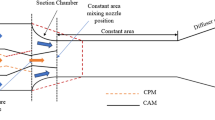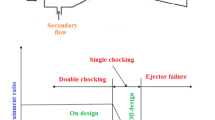Abstract
Pumping in ejectors is a measure of how much the secondary fluid is entrained by the high momentum primary flow and is one of the crucial performance indices. In the fuel recirculation system of fuel cells, the entrained secondary fluid contains water vapor due to the over-supplied hydrogen, making the secondary fluid humid. In such cases, the relative humidity of the secondary fluid alters the fluid properties of the mixed flow. This study examines such effects of relative humidity on ejector. A new analytical model has been developed, and series of measurements has been conducted to validate the model’s prediction. The present results demonstrate that higher relative humidity of the secondary fluid reduces pumping in an ejector. During the mixing process of the two fluids, condensation releases heat, increasing the ejector operating temperature. Thus, secondary flow density is decreased, and pumping is lowered.
Similar content being viewed by others
References
J. H. Keenan and E. P. Neumann, A simple air ejector, Journal of Applied Mechanics, 9 (1942) A75–A81.
J. H. Keenan, E. P. Neumann and F. Lustwerk, An investigation of ejector design by analysis and experiment, Journal of Applied Mechanics, 17 (1950) 299–309.
H. G. Elrod, The theory of ejectors, Journal of Applied Mechanics, 12 (1945) A170–A174.
I. W. Eames, S. Aphornratana and H. Haider, A theoretical and experimental study of a small-scale steam jet refrigerator, International Journal of Refrigeration, 18 (1995) 378–386.
B. J. Huang, J. M. Chang, C. P. Wang and V. A. Petrenko, A 1-D analysis of ejector performance, International Journal of Refrigeration, 18 (1999) 354–364.
W. M. Presz and E. M. Greitzer, A useful similarity principle for jet engine exhaust system performance, 24 th ASME, SAE, and ASEE Joint Propulsion Conference (1988).
S. A. Sherif et al. Analysis and modeling of a two-phase jet pump of a thermal management system for aerospace applications, International Journal of Mechanical Sciences, 42 (2) (2000) 185–198.
K. Cizungu. M. Groll and Z. G. Ling, Modelling and optimization of two-phase ejectors for cooling systems, Applied Thermal Engineering, 25 (13) (2005) 185–198.
M. Shafaee, M. Tavakol and R. Riazi, An investigation on the supersonic ejectors working with mixture of air and steam, Journal of Mechanical Science and Technology, 29 (11) (2015) 4491–4699.
F. Marsano, L. Magistri and A. F. Massardo, Ejector performance influences on a solid oxide fuel cell anodic recirculation system, Journal of Power Sources, 129 (2) (2004) 216–228.
M. Kim, Y. J. Sohn, C. W. Che, W. Y. Lee and C. S. Kim, Customized design for the ejector to recirculate a humidified hydrogen fuel in a submarine PEMFC, Journal of Power Sources, 172 (2) (2008) 529–533.
Y. Zhu and Y. Li, New theoretical model for convergent nozzle ejector in the proton exchange membrane fuel cell system, Journal of Power Sources, 191 (2) (2009) 510–519.
M. Engelbracht, R. Peters, L. Blum and D. Stolten, Comparison of a fuel-driven and steam-driven ejector in solid oxide fuel cell system, Journal of Power Sources, 277 (2009) 251–260.
P. T. Tsilingiris, Thermophysical and transport properties of humid air at temperature range between 0 and 100°C, Energy Conversion and Management, 49 (2008) 1098–1110.
E. M. Greitzer, R. W. Paterson and C. S. Tan, An approximate substitution principle for viscous heat conducting flows, Proceedings of the Royal Society of London. A. Mathematical and Physical Sciences, 401 (1985) 163–193.
W. Nusselt, Die Oberflachenkondensation des Wasserdampfes, Z. Ver. Deut. Ing., 60 (1916) 569–575.
W. M. Rohsenow, Heat transfer and temperature distribution in laminar film condensation, Trans. ASME, 78 (1956) 1645–1648.
M. Flouros, F. Cottier, M. Hirchnann, J. Kutz and A. Jocher, Ejector scavenging of bearing chambers. A numerical and experimental investigation, Journal of Engineering for Gas Turbines and Power, 135 (8) (2013) 081602.
T. A. Meakhail, Y. Zien, M. Elsallak and S. AbdelHady, Experimental study of some geometric variables and number of nozzles on the performance of a subsonic air-air ejector, Proceedings of the Institution of Mechanical Engineers, Part A: Journal of Power and Energy, 222 (8) (2008) 809–818.
A. Kabza, Fuel Cell Formulary (2013).
E. M. Greitzer, C. S. Tan and M. B. Graf, Internal flow: concepts and applications, Cambridge University Press.
H. W. Coleman and W. G. Steele, Experimentation, validation, and uncertainty analysis for engineers, John Wiley & Sons (2009).
X. Lin and K. G. Hubbard, Uncertainties of derived dewpoint temperature and relative humidity, Journal of Applied Meteorology, 43 (5) (2004) 821–825.
Author information
Authors and Affiliations
Corresponding author
Additional information
Recommended by Associate Editor Weon Gyu Shin
Hochae Lee is a Doctor of Philosophy candidate at Seoul National Univer- sity. He received his Bachelor of Engineering degree from Department of Mechanical and Aerospace Engineering, Seoul National University. His research interests include fluid machinery and turbomachinery
Rights and permissions
About this article
Cite this article
Lee, H., Jegal, S. & Song, S.J. Analysis and measurement of relative humidity effects on ejector performance. J Mech Sci Technol 31, 4237–4244 (2017). https://doi.org/10.1007/s12206-017-0822-9
Received:
Revised:
Accepted:
Published:
Issue Date:
DOI: https://doi.org/10.1007/s12206-017-0822-9




